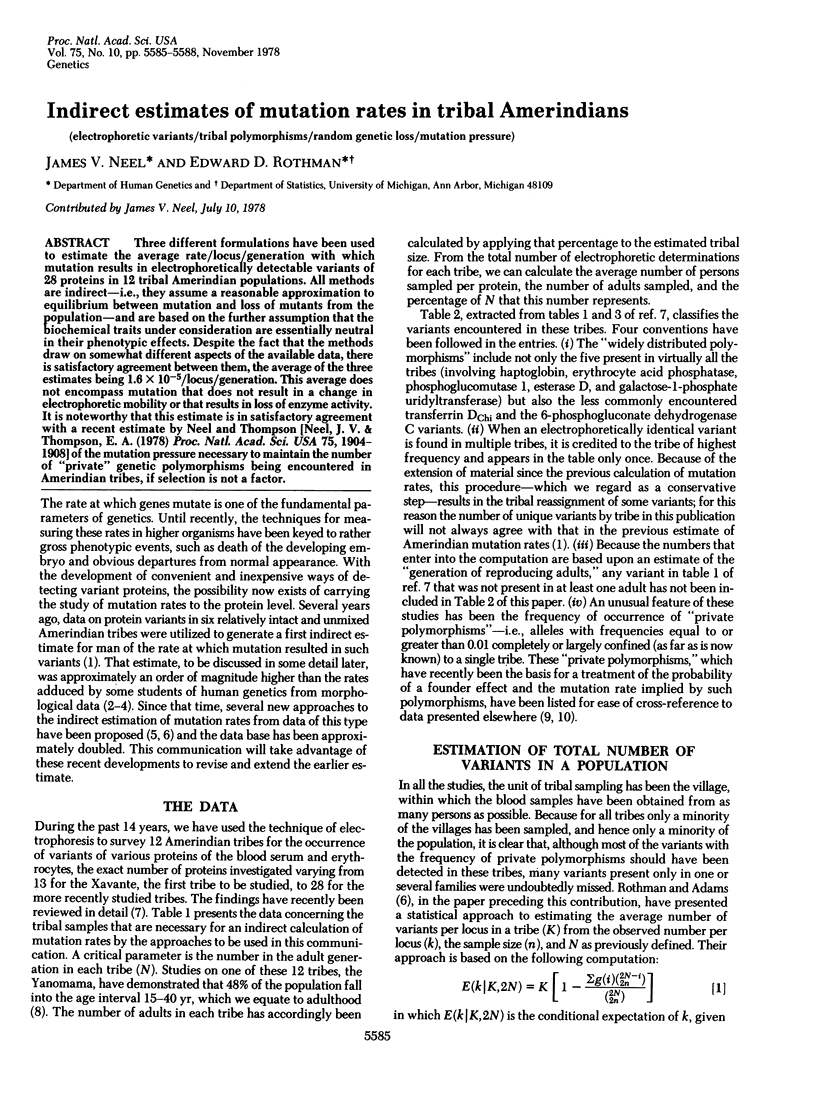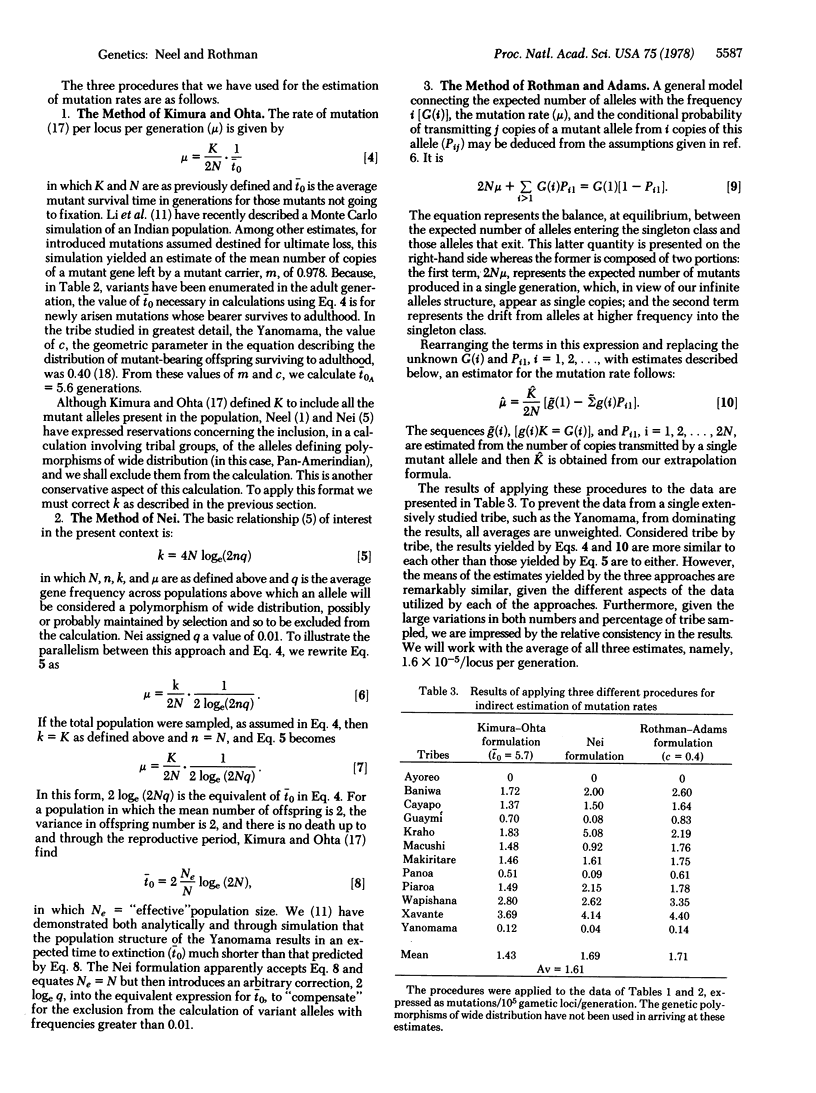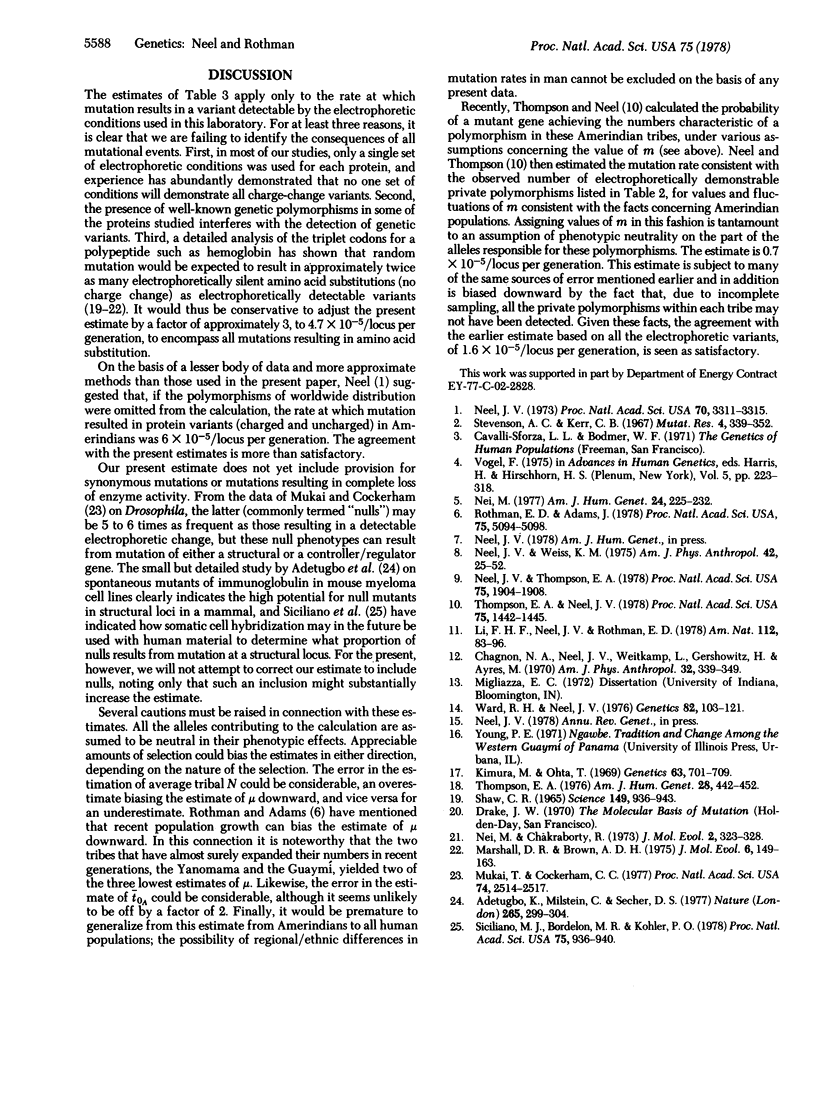Abstract
Three different formulations have been used to estimate the average rate/locus/generation with which mutation results in electrophoretically detectable variants of 28 proteins in 12 tribal Amerindian populations. All methods are indirect--i.e., they assume a reasonable approximation to equilibrium between mutation and loss of mutants from the population--and are based on the further assumption that the biochemical traits under consideration are essentially neutral in their phenotypic effects. Despite the fact that the methods draw on somewhat different aspects of the available data, there is satisfactory agreement between them, the average of the three estimates being 1.6 X 10(-5)/locus/generation. This average does not encompass mutation that does not result in a change in electrophoretic mobility or that results in loss of enzyme activity. It is noteworthy that this estimate is in satisfactory agreement with a recent estimate by Neel and Thompson [Neel, J. V. & Thompson, E. A. (1978) Proc. Natl. Acad. Sci. USA 75, 1904--1908] of the mutation pressure necessary to maintain the number of "private" genetic polymorphisms being encountered in Amerindian tribes, if selection is not a factor.
Full text
PDF



Selected References
These references are in PubMed. This may not be the complete list of references from this article.
- Adetugbo K., Milstein C., Secher D. S. Molecular analysis of spontaneous somatic mutants. Nature. 1977 Jan 27;265(5592):299–304. doi: 10.1038/265299a0. [DOI] [PubMed] [Google Scholar]
- Chagnon N. A., Neel J. V., Weitkamp L., Gershowitz H., Ayres M. The influence of cultural factors on the demography and pattern of gene flow from the Makiritare to the Yanomama Indians. Am J Phys Anthropol. 1970 May;32(3):339–349. doi: 10.1002/ajpa.1330320304. [DOI] [PubMed] [Google Scholar]
- Kimura M., Ota T. The average number of generations until extinction of an individual mutant gene in a finite population. Genetics. 1969 Nov;63(3):701–709. doi: 10.1093/genetics/63.3.701. [DOI] [PMC free article] [PubMed] [Google Scholar]
- Marshall D. R., Brown A. H. The charge-state model of protein polymorphism in natural populations. J Mol Evol. 1975 Nov 4;6(3):149–163. doi: 10.1007/BF01732353. [DOI] [PubMed] [Google Scholar]
- Mukai T., Cockerham C. C. Spontaneous mutation rates at enzyme loci in Drosophila melanogaster. Proc Natl Acad Sci U S A. 1977 Jun;74(6):2514–2517. doi: 10.1073/pnas.74.6.2514. [DOI] [PMC free article] [PubMed] [Google Scholar]
- Neel J. V. "Private" genetic variants and the frequency of mutation among South American Indians. Proc Natl Acad Sci U S A. 1973 Dec;70(12):3311–3315. doi: 10.1073/pnas.70.12.3311. [DOI] [PMC free article] [PubMed] [Google Scholar]
- Neel J. V., Thompson E. A. Founder effect and number of private polymorphisms observed in Amerindian tribes. Proc Natl Acad Sci U S A. 1978 Apr;75(4):1904–1908. doi: 10.1073/pnas.75.4.1904. [DOI] [PMC free article] [PubMed] [Google Scholar]
- Neel J. V., Weiss K. M. The genetic structure of a tribal population, the Yanomama Indians. XII. Biodemographic studies. Am J Phys Anthropol. 1975 Jan;42(1):25–51. doi: 10.1002/ajpa.1330420105. [DOI] [PubMed] [Google Scholar]
- Nei M., Chakraborty R. Genetic distance and electrophoretic identity of proteins between taxa. J Mol Evol. 1973 Nov 27;2(4):323–328. doi: 10.1007/BF01654100. [DOI] [PubMed] [Google Scholar]
- Nei M. Estimation of mutation rate from rare protein variants. Am J Hum Genet. 1977 May;29(3):225–232. [PMC free article] [PubMed] [Google Scholar]
- Rothman E. D., Adams J. Estimation of expected number of rare alleles of a locus and calculation of mutation rate. Proc Natl Acad Sci U S A. 1978 Oct;75(10):5094–5098. doi: 10.1073/pnas.75.10.5094. [DOI] [PMC free article] [PubMed] [Google Scholar]
- Shaw C. R. Electrophoretic variation in enzymes. Science. 1965 Aug 27;149(3687):936–943. doi: 10.1126/science.149.3687.936. [DOI] [PubMed] [Google Scholar]
- Siciliano M. J., Bordelon M. R., Kohler P. O. Expression of human adenosine deaminase after fusion of adenosine deaminase-deficient cells with mouse fibroblasts. Proc Natl Acad Sci U S A. 1978 Feb;75(2):936–940. doi: 10.1073/pnas.75.2.936. [DOI] [PMC free article] [PubMed] [Google Scholar]
- Stevenson A. C., Kerr C. B. On the distribution of frequencies of mutation to genes determining harmful traits in man. Mutat Res. 1967 May-Jun;4(3):339–352. doi: 10.1016/0027-5107(67)90029-2. [DOI] [PubMed] [Google Scholar]
- Thompson E. A. Estimation of age and rate of increase of rare variants. Am J Hum Genet. 1976 Sep;28(5):442–452. [PMC free article] [PubMed] [Google Scholar]
- Thompson E. A., Neel J. V. Probability of founder effect in a tribal population. Proc Natl Acad Sci U S A. 1978 Mar;75(3):1442–1445. doi: 10.1073/pnas.75.3.1442. [DOI] [PMC free article] [PubMed] [Google Scholar]
- Ward R. H., Neel J. V. The genetic structure of a tribal population, the Yanomama Indians. XIV. Clines and their interpretation. Genetics. 1976 Jan;82(1):103–121. doi: 10.1093/genetics/82.1.103. [DOI] [PMC free article] [PubMed] [Google Scholar]


